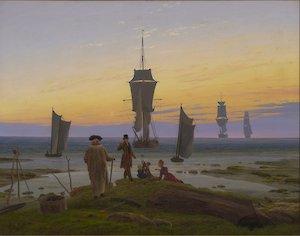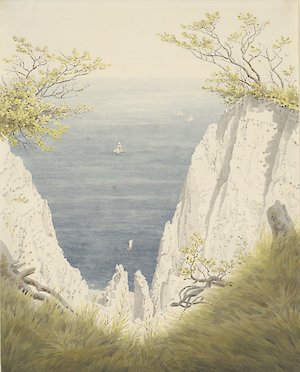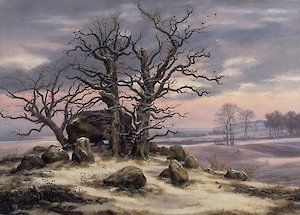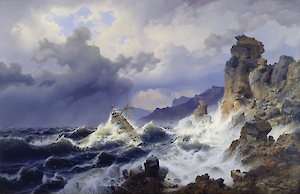Caspar David Friedrich and the Düsseldorf Romanticists
Caspar David Friedrich and the Düsseldorf Romanticists
09/10/2021 — 09/01/2022







Due to the order of the State of Saxony, the MdbK is closed until and including 14th January 2022. For organisational reasons, the exhibition Caspar David Friedrich and the Düsseldorf Romanticists can unfortunately not be extended. We regret this very much and thank you at this point for your understanding!
During his lifetime, Caspar David Friedrich (1774-1840), the most eminent artist of German early Romanticism, had a lively relationship with various representatives of Düsseldorf landscape painting. It was marked by criticism and polemics but also by mutual recognition. From the 1820s onwards, Friedrich's work lost popularity and was finally eclipsed by the up-and-coming Düsseldorf School of Painting.
The exhibition comprising approximately 120 works illustrates the changes in taste occurring in the period between early Romanticism and the beginnings of the Realist movement. For the first time Saxonian landscape painting forms a dialogue with works of the Düsseldorf School of Painting. Around 30 paintings and 20 drawings by Friedrich, as well as works by his Dresden colleagues Carl Gustav Carus (1789-1869), Ludwig Richter (1803-1884) and Ernst Ferdinand Oehme (1797-1855) are juxtaposed with paintings by the Düsseldorf artists Andreas (1815-1910) and Oswald Achenbach (1827-1905), Carl Friedrich Lessing (1808-1880), Johann Wilhelm Schirmer (1807–1863) and others.
The first half of the 19th century saw a lively and multifaceted cultural exchange between the Rhineland region and Saxony. From 1826, Friedrich exhibited at a variety of German art academies, as did the director of the Düsseldorf Academy of Art, Wilhelm Schadow (1788-1862), and members of the early generation of the Düsseldorf School of Painting. According to Friedrich, contemplation of nature was meant to facilitate an exploration of the inner self; landscape paintings were not merely intended to depict nature, but to arouse emotions, as is symbolised by the Rückenfigur motif (figure seen from behind). From the late 1820s onwards, works by artists in both Düsseldorf and Saxony made reference to Friedrich’s paintings. However, paintings by Düsseldorf artists increasingly exhibited more dramatism and pathos, as well as being of a considerably larger format; they told stories and were convincingly refined technically. This style of painting gradually had an increasing influence, particularly on the Saxonian art scene, and thus, leading Düsseldorf painters were eventually awarded professorships at the Dresden Academy.
Presented in eight sections ranging from studio scenes to a variety of landscape themes, the exhibition explores the ways in which Dresden Romanticism came to be superseded by the Düsseldorf style of painting, as well as addressing the social developments underlying this change in taste. Alongside native landscapes, maritime paintings and moonlit nocturnes, the exhibition also illuminates the plein air study as a working method. Referring to issues such as ephemerality – a central theme in Romantic art – the exhibition illustrates the evolution of painting from the silent contemplation of Caspar David Friedrich to the social satire occurring in genre paintings by Düsseldorf artists. Further interesting contrasts are demonstrated by comparing Friedrich’s contemplative Rocky Reef on the Sea Shore to the stormy dramatism of Andreas Achenbach’s Storm at Sea off the Norwegian Coast. Important loans from the Alte Nationalgalerie, Berlin, Hamburger Kunsthalle, Folkwang Museum Essen, Musée du Louvre, Paris, Staatliche Kunsthalle Karlsruhe, Städel Museum, Frankfurt, Thyssen-Bornemisza Museum, Madrid, as well as a variety of other renowned public and private collections complement the extensive show.
The exhibition is a collaboration between the MdbK and the Kunstpalast Düsseldorf (15.10.2020–4.5.2021). It was curated by Bettina Baumgärtel (Kunstpalast Düsseldorf) and Jan Nicolaisen (MdbK).
The exhibition in Leipzig and the catalogue were funded by the Art Foundation of the Federal States, the Ernst von Siemens Art Foundation, the Art Mentor Foundation Lucerne, the Rudolf August Oetker Foundation and the Maximilian Speck von Sternburg Foundation.
EXHIBITION PROGRAMME
The exhibition will be accompanied by an extensive programme of talks, workshops, guided tours, offers for schools and much more (see attachment). Depending on the pandemic situation, the events will be offered on-site, as hybrids or digitally.
EXHIBITION CATALOGUE
The exhibition is accompanied by a 208-page catalogue published by Sandstein Verlag with numerous colour illustrations and texts by Bettina Baumgärtel, Johannes Grave, Florian Illies, Jan Nicolaisen and Maria Zinser. The museum edition is available at the MdbK for 29,80 Euro, the bookstore edition costs 38 Euro.
Due to the museum closure, the publication is currently not available at the ticket office. If you would like to purchase the catalogue from us, please send your order to our administration department (verwaltung.mdbk@leipzig.de), stating the delivery/invoice address. You will then receive the publication by post, with an invoice and bank transfer details enclosed.
Attention: Due to time constraints, ordering as a Christmas present is only possible until 14.12.2021 at the latest!

